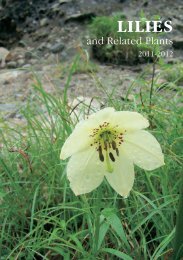LILIES - RHS Lily Group
LILIES - RHS Lily Group
LILIES - RHS Lily Group
You also want an ePaper? Increase the reach of your titles
YUMPU automatically turns print PDFs into web optimized ePapers that Google loves.
Threatened species<br />
As a result of our original research since 1996, it was clarified that 24 species<br />
officially included in the Red Data Book of Russia (2005) occur in the Lower Khoper<br />
Nature Park, these are: Artemisia hololeuca Bieb. ex Bess., A. salsoloides Willd.<br />
(Asteraceae), Lepidium meyeri Claus, Matthiola fragrans Bunge (Brassicaceae),<br />
Silene cretacea Fisch., S. hellmannii Claus (Caryophyllaceae), Scrophularia<br />
cretacea Fisch. (Scrophulariaceae), Astragalus tanaiticus C. Koch, Hedysarum<br />
cretaceum Fisch., H. grandiflorum Pall. (Fabaceae), Allium regelianum<br />
A. Beck. (Alliaceae), Bulbocodium versicolor (Ker-Gawl.) Spreng. (Colchicaceae),<br />
Bellevalia speciosa (Georgi) Woronow (Hyacinthaceae), Fritillaria ruthenica<br />
Wikstr., Tulipa schrenkii Regel (Liliaceae), Iris aphylla L. (Iridaceae),<br />
Hyssopus cretaceus Dubjan. (Lamiaceae), Stipa dasyphylla (Lindem), Trautv.,<br />
S. pennata L., S. pulcherrima C. Koch (Poaceae), Orchis coriophora L.,<br />
O. militaris L., O. palustris Jacq. (Orchidaceae), Paeonia tenuifolia<br />
L. (Paeoniaceae). Iris pumila L. was included in the first edition of the Red Data<br />
Book of Russia (1988), it also grows in this territory.<br />
The main factor causing the disappearance of many steppe plants was<br />
ploughing up of virgin steppe but even hay making has an influence on the<br />
population and distribution of certain species (for example, Allium regelianum<br />
and Fritillaria meleagroides). First of all, this is true for those meadow-steppe<br />
species which have unripe seeds in the hay making season. So, in hay making<br />
areas one cannot find Bellevalia speciosa. It cannot be propagated vegetatively<br />
with bulbils but only by seed and plants must pass through difficult and complex<br />
phases of development during several years before they come into flower. And<br />
under continuous cutting of the grass the mother bulb is gradually exhausted<br />
and dies (Firsov, Baranova, 2002). Our inspection of chalk hills of the Khoper<br />
River from khutor Koso-Kluchansky downwards to the mouth of Kumilga River<br />
in July 2001 showed that certain plants, such as bulbous alliums, grow only on a<br />
very narrow strip along the precipitous bank of the river, at times only 2 to 5 m<br />
wide, from the edge of the upland oak wood or edge of the slope to the edge<br />
of field or hay making area. It is the bulbous species that are most at peril from<br />
the plough which throws them up to the soil surface where they soon dry out<br />
and perish.<br />
At present the situation with plant conservation has changed considerably.<br />
The Red Data Book of the Volgograd region has been published and the<br />
“Nizhnekhopersky” and “Ust-Medveditsky” parks have been established at<br />
the lower reaches of the Khoper and Medveditsa rivers. In total seven nature<br />
parks were recently created in the Volgograd region. We hope this will<br />
help to conserve and protect large areas of steppe vegetation for future<br />
generations.<br />
109




